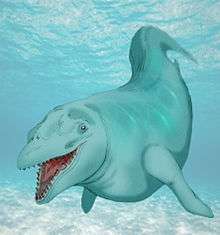Masracetus
Masracetus (from Arabic Masr, "Egypt", and Greek ketos, "whale")[1] is an extinct genus of basilosaurid ancient whale known from the Late Eocene (Priabonian, 37.2 to 33.9 million years ago) of Egypt.[2]
| Masracetus | |
|---|---|
 | |
| Restoration | |
| Scientific classification | |
| Kingdom: | Animalia |
| Phylum: | Chordata |
| Class: | Mammalia |
| Order: | Artiodactyla |
| Infraorder: | Cetacea |
| Family: | †Basilosauridae |
| Subfamily: | †Dorudontinae |
| Genus: | †Masracetus Gingerich 2007 |
| Species | |
| |
Masracetus was briefly described in an addendum by Gingerich 2007 and is known from just an assemblage of vertebrae and a poorly reconstructed skull from 1908. The lumbar vertebrae are large but relatively short (anteroposteriorly) compared to those of other archaeocetes; the diameter is almost the same as for Basilosaurus isis but the length is less than half of the latter. Masracetus is larger than Cynthiacetus.[3]
The species name honours Richard Markgraf, palaeontologist Ernst Stromer's fossil collector, who collected the type specimen in 1905.[1]
Masracetus' type locality is the Birket Qarun Formation in Dimê (29.5°N 30.7°E, paleocoordinates 24.9°N 26.6°E) north of lake Birket Qarun,[4] but specimens have also been found in the Qattara Depression and Fayum.[5][6][7][8]
Notes
- Gingerich 2007, Etymology, p. 375
- Masracetus in the Paleobiology Database. Retrieved July 2013.
- Gingerich 2007, p. 375
- Dimeh (Eocene of Egypt) in the Paleobiology Database. Retrieved July 2013.
- Masracetus markgrafi in the Paleobiology Database. Retrieved July 2013.
- Qattara Depression (Eocene of Egypt) in the Paleobiology Database. Retrieved July 2013.
- Minqar Tibaghbagh (Eocene of Egypt) in the Paleobiology Database. Retrieved July 2013.
- Minqar el-Hut (Eocene of Egypt) in the Paleobiology Database. Retrieved July 2013.
References
| Wikispecies has information related to Masracetus |
- Gingerich, Philip D (2007). "Stromerius nidensis, new archaeocete (Mammalia, Cetacea) from the Upper Eocene Qasr El-Sagha Formation, Fayum, Egypt" (PDF). Contributions from the Museum of Paleontology. 31 (13): 363–78. OCLC 214233870.CS1 maint: ref=harv (link)